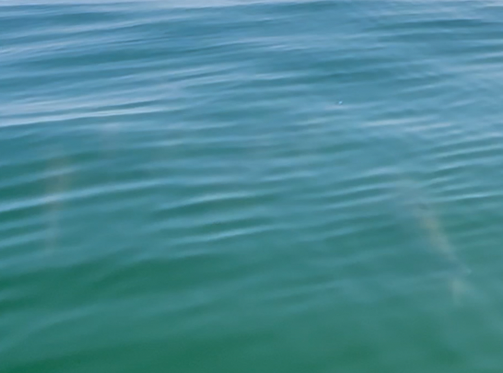Usually associated with warmer areas, the legendary sport fish is a rare sight in the state

Blurry shapes just below the surface of the Chesapeake Bay, multiple tarpon school together in waters near Hoopers Island Lighthouse on Aug. 1. Credit: Tom Weaver
Scouting for red drum near the Hoopers Island Lighthouse on Aug. 1, Capt. Tom Weaver saw something roll in the flat, calm waters a couple hundred yards away.
He looked for the wake and followed a disturbance in the distance. When he got close and shut the motor off, he saw huge shapes under the water. The fish looked familiar—and Weaver soon realized he recognized them from his years fishing in the Florida Keys.
“When you run out of Annapolis, you don’t expect an hour and a half later to be running across a tarpon,” Weaver, who runs a charter business Fish With Weaver, said. “My brain took a few minutes to process.”
Tarpon are large, athletic fish renowned for how they fight the line, with both incredible stamina and an ability to leap out of the water, their bodies thrashing in the air.
In a video Weaver recorded, hulking 6-foot-long fish lurk motionless under the surface. They were tanks, he said, each maybe 80 to 100 pounds. He went after the group of seven or eight tarpon for a while and got a bite, though he didn’t have the right gear to pull one in. “Really, we were not ready to see tarpon,” he said.
Erik Zlokovitz, Maryland Department of Natural Resources’ recreational fisheries outreach coordinator, said the department is getting more reports of tarpon, usually associated with warmer southern waters, in Maryland this summer.
“We have seen tarpon in Maryland’s section of the bay historically, but the number of fish spotted recently is unusual,” Zlokovitz said. “This year is the first time we’ve gotten multiple reports of schools of tarpon, and not just a stray fish.”
Tarpon are known to come into the southern Chesapeake Bay in the summer, and anglers target tarpon in the coastal waters off the Eastern Shore of Virginia. But it’s usually rare for anyone to encounter a tarpon in Maryland waters.
In 2019, DNR staff sampling for striped bass netted and released a small tarpon near Kent Island. Angler Brittany Growe hooked a 6-foot-long tarpon near Smith Island and the Virginia border in July 2020. Her fishing partner touched the leader before the hook pulled out with the fish next to the boat, making it an official catch and release.
Older references also note occasional sightings. In the 1927 publication for the U.S. Bureau of Fisheries “Fishes of the Chesapeake Bay,” authors Samuel F. Hildebrand and William C. Schroeder wrote that tarpon “was reliably reported by fisherman in the southern parts of Chesapeake Bay” and referred to an earlier list of fish species in Maryland from 1878 that reported a tarpon caught off Crisfield.
Weaver said when he told people about his find, two other guides said they had also seen tarpon in Maryland in the last week. He saw a school of tarpon moving fast in the Bay last year too, and people he’s spoken with have only seen tarpon in Maryland waters in the past two years.
Zlokovitz said it’s too early to tell if the apparent uptick in tarpon is an “anomaly or the start of a trend.”
Water temperatures have risen in the Chesapeake Bay in recent decades, and climate change is affecting Maryland’s biodiversity. A number of warm-water fish species—from Florida pompano to cobia, cutlassfish, and pompano dolphinfish—are becoming more common in the Bay and the Atlantic coast.
Warming waters could be drawing tarpon farther north, or they could be traveling farther in pursuit of food sources like menhaden and shrimp, DNR scientists said. It could also be a larger northern migration this year. A surfcaster in Rhode Island caught a tarpon this summer.
Water temperatures have increased in the Chesapeake Bay over the last three decades, with most DNR monitoring stations showing an increase between 1 and 2 degrees Fahrenheit since 1999. This summer has been hot as well, with monitoring stations recording above average temperatures near Hoopers Island, according to DNR data.
When Weaver saw the tarpon, he thought they were “slurping on blue crabs” that were swimming nearby. Regretting that he didn’t have fly rods on board, he pulled out the smallest paddle tails he could find and did his best to hook one. Next time, he’s bringing crab flies and plans to be ready. He wants to catch a tarpon in Maryland, or even just get one to jump.
“I’m gonna have a dedicated tarpon setup on the boat—rig and fly,” Weaver said. “I’m not going to make that mistake again.”
Tarpon are generally considered undesirable for eating, and DNR officials recommend anglers only pursue tarpon for catch-and-release fishing.
By Joe Zimmermann, science writer with the Maryland Department of Natural Resources.
